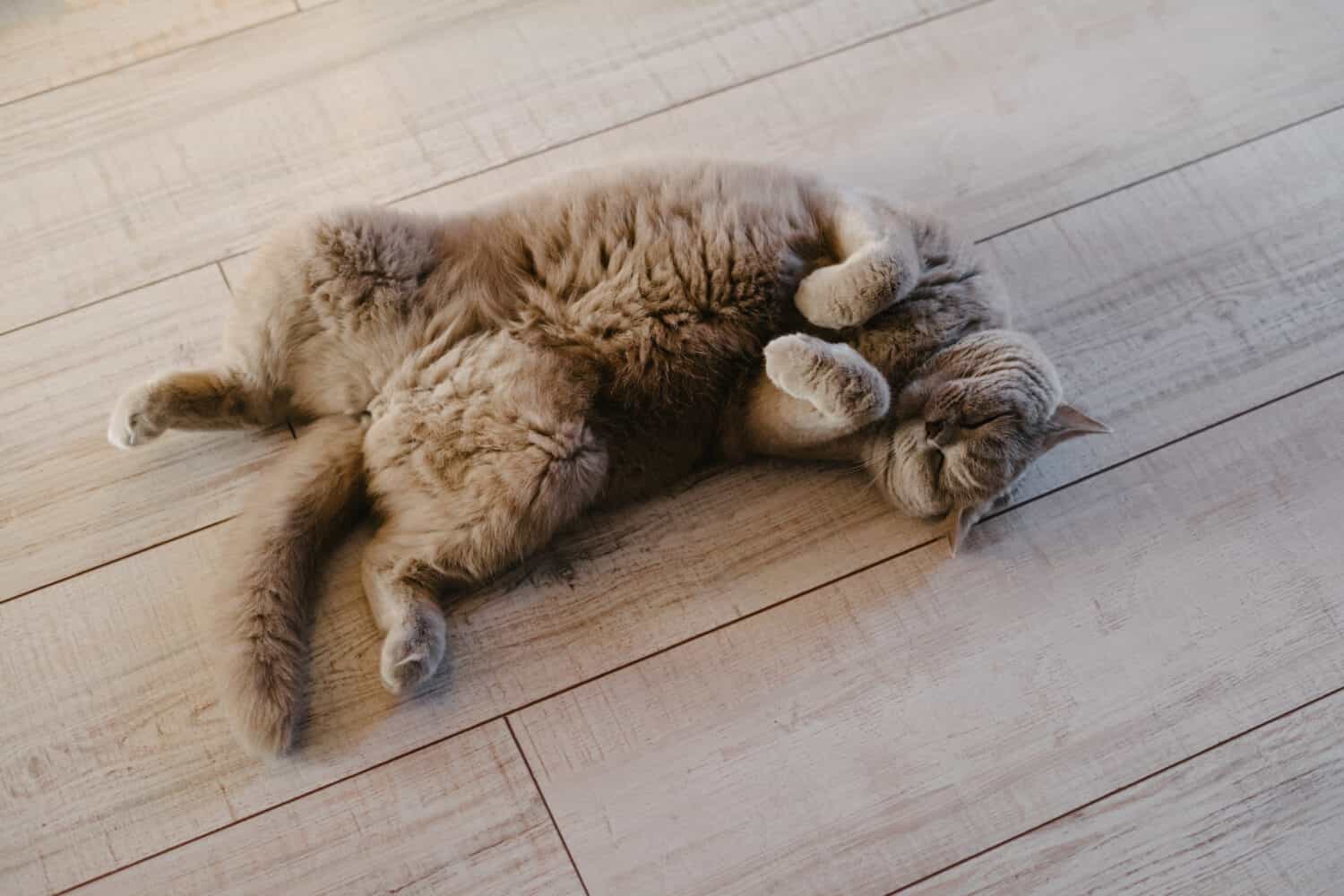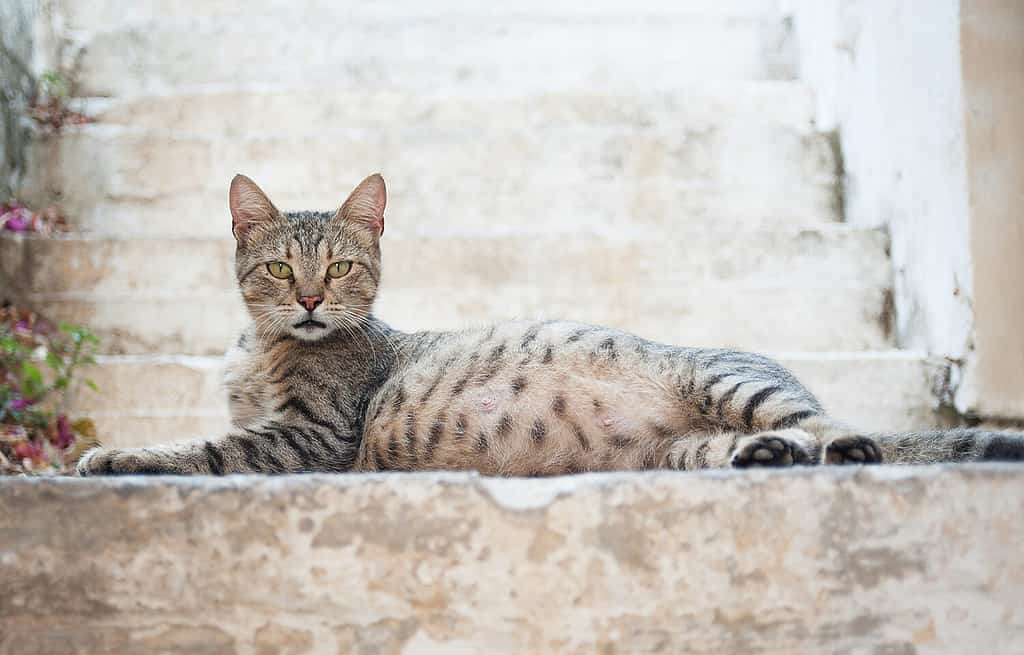Like with humans, milk production in cats when preparing to nurse their babies is a pivotal process. Her kittens need the nourishment she provides them with for the first couple of months after they are born. If you have a female cat who’s soon to be a mama cat, you may be questioning the difference between normal cat nipples vs. pregnant cat nipples. Interestingly, changes to the nipples are one of the first signs you may be privy to (as soon as two weeks after she conceives!). To understand the differences to look for between a preggo kitty and a non-preggo kitty, you first need a short anatomy lesson!
Normal Cat Nipples
Basic Cat Nipple Anatomy
There isn’t one specific number of nipples a cat has. In some cats, there are only four while in others there may be ten. Usually, they’re in even numbers but sometimes, they might appear in odd numbers. On average, however, cats have either six or eight nipples. They sit alongside one another in two rows with the nipples on each side aligned with one another.
Behind each of the nipples are mammary glands. These are quite tiny and typically, they’re dormant when not needed. When kittens latch on to the tip of the cat’s nipples, they are pulling the milk from the small opening at the edge of the nipple (which is called the teat canal). That canal connects to the mammary glands. Only cats that are pregnant or that are actively nursing their kittens should produce milk (sometimes they produce discharge as well).
Male Cat Nipples
Just because they don’t nurse kittens doesn’t mean male cats don’t have nipples! At one point in a male cat’s development, there was no certainty that it would become male. Nipples develop extremely early, way before hormones start dictating the sex of a kitten. In male cats, nipples are just little adornments. They don’t serve any useful purpose but are a reminder of their early development. In both males and non-pregnant females, nipples are kind of hard to spot. Sometimes, there is slight balding around each nipple, which helps in finding them but other times, the fur closes in on each individual nipple.

Due to furry bellies, it’s not always easy to spot nipples on cats.
©Alice Rodnova/Shutterstock.com
Pregnant Cat Nipples
Now you have an idea of normal cat nipples. But what about pregnant cat nipples? When a female cat is pregnant, she goes through several changes. You know that changes in your cat’s nipples are one of the first indications that she is pregnant but as her belly grows, how else are her nipples going to change? Let’s go state-by-stage!
Early Pregnancy Stage
Around two weeks after conception, your cat’s nipples are already rearing up for what’s to come. Their color changes, shifting to more of a darker hue and they also become a bit bigger. Along with becoming more prominent, the fur (if any) surrounding the nipple starts to clear out, which is a helpful process for her kittens when they start looking for their source of sustenance. It’s too early during this first stage for you to notice any kind of discharge.
Late Pregnancy Stage
As your cat’s belly keeps growing and her walking movements change a bit, her nipples are only going to get bigger and more visible. It’s during the first stage of pregnancy that those big noticeable changes start happening to her nipples. The rest of the pregnancy allows for further preparation. Since your cat’s belly continues to expand, her nipples become even more apparent and the little hairless patches around her nipples swell. A cat’s pregnancy lasts between 60 and 70 days and about two days before she’s ready to give birth, you may notice milky discharge. This isn’t a cause for concern. It just means she’s ready to feed her kittens! Even if you don’t see this discharge, which may also be kind of clear, it’s not an indication that she isn’t producing milk. Only some cats experience this symptom prior to giving birth.

Kittens start nursing right after birth.
©Vitalii Stock/Shutterstock.com
Nursing Stage
The moment your mama cat and the kittens have been waiting for! Once the little ones are out of mama’s belly, they immediately gravitate over to her enlarged nipples. With stimulation provided by the kittens’ eager suckles and tiny paws, she starts producing milk to feed them. The milking station is open and in full swing at this point. The nipples will remain enlarged and have a darker hue, each time making it easy for her kittens to find them and latch on. When the kittens naturally wean off their mother’s milk, your female cat’s nipples slowly start to return to their pre-pregnancy size and appearance.
How Do You Know Your Cat Is About To Give Birth?

There are some signs that can indicate your pregnant cat is about to go into labor.
©Jim Polakis/Shutterstock.com
There are some tell-tale signs that would indicate that your cat is near or going into labor. It’s important to be aware of what to look for so that you are prepared to help your cat if needed or get proper care if something is awry. Below are some symptoms to watch for that could indicate your dog is in labor:
- 2 days before giving birth, her mammary glands will enlarge and begin to produce milk
- Her body temperature will drop to a range of 100°-102.5°
- She’ll exhibit hiding or nesting behavior
- She’ll have a decrease in or loss of appetite
- She may exhibit restless or clingy behavior
- Excessive licking of the genital area
- She may become more vocal by chirping or howling
- Hardened belly
A normal cat will usually deliver all her kittens within approximately 6 hours. It’s important to have her on a special high-calorie diet during her 2-month gestation period through the time she’s nursing.
The photo featured at the top of this post is © Esin Deniz/Shutterstock.com
Thank you for reading! Have some feedback for us? Contact the AZ Animals editorial team.






